|
Forged in Fire
by Peter Howe
The official announcement
came at Visa Pour L'Image in Perpignan on Thursday September 6th 2001.
Seven photographers, all of whom were world renowned for their coverage
of international turmoil, would come together to form an agency called
VII. If timing is everything, then the timing of the announcement was
uncanny. Less than a week later the world would be plunged into the
first major conflict of the twenty first century, the war against terrorism.
The first battles of this war would be fought by a coalition of America
and Britain. Of the seven photographers only one, Alexandra Boulat,
was not a citizen or resident of either nation. The conflict would be
precipitated by the attacks on the World Trade Center. These occurred
a few blocks from the apartment of one of them, James Nachtwey, giving
him an advantage in timing that helped him be in a position to shoot
some of the most powerful coverage of that tragic event. Both during
and after the attacks the public's need for images seemed insatiable.
Special editions of news magazines were rushed into print; newspapers
devoted more and more space to photography; books dedicated to the event
and to its heroes were hurriedly planned; a remarkable exhibition of
images grew almost organically in the SoHo district of New York.
If VII is an idea whose time has come, then the time is now.
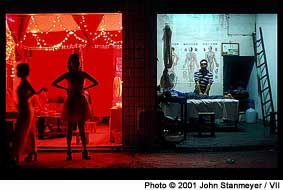 Shortly
before the press conference that would be the vehicle for the announcement
The Digital Journalist was given an exclusive interview with
all of the photographers and VII's managing editor Ashley Woods. Their
attendance at this year's Visa was the first time ever that they had
all been together in the same room. It is a testament to the revolution
in communication that the seven photographers, Alexandra Boulat, Ron
Haviv, Gary Knight, Antonin Kratochvil, Christopher Morris, James Nachtwey
and John Stanmeyer, could conceive, structure and realize an agency
without the need to have a meeting with everyone physically present.
It was also appropriate that the announcement should have been in Perpignan
because it was at Visa the previous year that the final decision to
move ahead was made by Alexandra, Gary and Ron in a nearby café. Shortly
before the press conference that would be the vehicle for the announcement
The Digital Journalist was given an exclusive interview with
all of the photographers and VII's managing editor Ashley Woods. Their
attendance at this year's Visa was the first time ever that they had
all been together in the same room. It is a testament to the revolution
in communication that the seven photographers, Alexandra Boulat, Ron
Haviv, Gary Knight, Antonin Kratochvil, Christopher Morris, James Nachtwey
and John Stanmeyer, could conceive, structure and realize an agency
without the need to have a meeting with everyone physically present.
It was also appropriate that the announcement should have been in Perpignan
because it was at Visa the previous year that the final decision to
move ahead was made by Alexandra, Gary and Ron in a nearby café.
As was repeated several times during the interview, the idea behind
VII is not new. There have been and still are many photographer cooperatives,
a term that some members of VII feel inappropriate for their partnership.
As each of them describes the unit it sounds more like a friendship,
even a brotherhood (if Alexandra will forgive the sexist categorization),
than a business. It is a remarkably cohesive group, and for Jim Nachtwey
this is a strength:
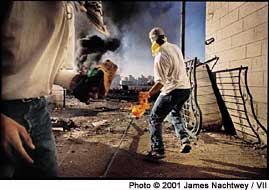 "The
focus [of VII] is very tight. We're committed to the same kind of documentation
of contemporary history, therefore we have many interests in common,
and we have many needs in common. This particular group with this particular
profile enables us to maintain a sharp focus on the things that are
meaningful to us as photographers. Through the years the friendships
that we have with each other are collegial relationships that have been
forged in extremely difficult situations. Those relationships that have
been forged in the field in real working conditions have brought us
together and that's what is going to keep us together." "The
focus [of VII] is very tight. We're committed to the same kind of documentation
of contemporary history, therefore we have many interests in common,
and we have many needs in common. This particular group with this particular
profile enables us to maintain a sharp focus on the things that are
meaningful to us as photographers. Through the years the friendships
that we have with each other are collegial relationships that have been
forged in extremely difficult situations. Those relationships that have
been forged in the field in real working conditions have brought us
together and that's what is going to keep us together."
John Stanmeyer puts it more succinctly when he describes the make up
of the partnership:
"It's seven individuals with seven perspectives that also wonderfully
unite."
One of the most important differences between this and similar groups
is the total commitment to using the Internet as the sole method of
display and delivery of the available work. They believe that there
are many advantages to this, not the least of which is the ability to
keep a small number of support staff, thereby substantially reducing
the agency overheads. Ashley Woods says that they need a staff that
is flexible and which will travel extensively (although he wants to
make it quite clear that there will always be someone to answer the
phone.) He believes: "The agency will run itself quite easily."
This is not a struggling group of photographers trying to make their
mark on the world but a partnership of some of the most established
and high profile shooters working today. It might be described as an
elite, and indeed has been so characterized by some including Le
Monde. If it seems that some members of the group have difficulty
with the term "cooperative" then they are unified in their
insistence that they are not an "elite". The fact that each
one of them is in a position to not worry about getting assignments
is important to the operation of the agency. Chris Morris puts it this
way:
 "We're
not photographers who are in need or in constant search of work. If
one of us needs to go to Israel or one of us needs to do a story on
Indonesia we can get there. We don't have to use the agency's resources
to get there. We are constantly producing stories because we are constantly
on assignment. Right away that separates our agency." "We're
not photographers who are in need or in constant search of work. If
one of us needs to go to Israel or one of us needs to do a story on
Indonesia we can get there. We don't have to use the agency's resources
to get there. We are constantly producing stories because we are constantly
on assignment. Right away that separates our agency."
These seven photographers are constantly on assignment but the stories
that they cover are often similar and sometimes the same. It is not
inconceivable that several photographers from VII might cover a situation
for several different magazines. Because the revenues of an agency whose
photographers are on assignment come from secondary sales, there appears
to be a danger that they would end up competing against each other for
this subsequent usage. For John Stanmeyer the answer is in the film:
"We've all been in similar situations almost standing next to each
other. Look at the film and it's three completely different perspectives.
I don't see any fingerprint duplication whatsoever."
For Chris Morris working in concert with his partners is a plus for
his photography:
"Jim and myself, numerous times we have been together in the same
country covering the same conflict for the same client and for me all
that does is raise my photography to a higher level because I'm with
peers that I respect. If I'm there by myself I might not do as well,
but if I know that Jim is there or another colleague, especially now
that we're in the same agency it's just going to make us produce better
work."
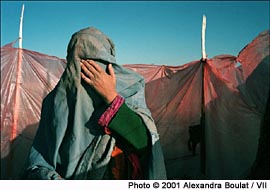 Alexandra
Boulat brings a different perspective to the issue. She feels that there
is a real possibility that for her, and maybe some of the others, meeting
in the field is going to be less and less likely as her photography
develops: Alexandra
Boulat brings a different perspective to the issue. She feels that there
is a real possibility that for her, and maybe some of the others, meeting
in the field is going to be less and less likely as her photography
develops:
"We are at the time of our lives where we may not be doing the
same thing that we were doing up to now. We all met in places where
we were working together because it was the time for us to do this kind
of story, but it's very possible that now that I will never meet any
one of them on the field because I'm working on different stories."
In many ways the odd man out is Antonin Kratochvil, a position that
he is not only used to but seems to delight in. During the press conference
that followed he spoke in his native Czech after Alexandra spoke in
her native French, gleefully realizing that not only would there be
few people in the audience that understood him but that it was also
unlikely that the little translation headphones that many of us were
using had a Czech channel. For Jim Nachtwey Antonin's larger-than-life
presence in the agency is much more important than just for raising
the fun quotient:
"Antonin is someone who expands our profile. He does something
that's somewhat different, sometimes very different but it's still in
this realm of social documentation."
Although this is true, it's still social documentation being sold into
the editorial market, which is the most challenged area of a severely
challenged industry. For Gary Knight far from being a deterrent this
is valid another reason for starting VII:
 "The
reason for setting up VII was to ensure our survival in that market
so that we can continue to produce those pictures. We will have strong
relationships with a small number of magazines that we hope will continue
at least in the short term and enable us to bridge the gap before we
hope we will be able to find new resources to produce this work and
it might not be the traditional editorial market. It may well be from
other areas that we will find funding, and that's what we're going to
explore quite aggressively." "The
reason for setting up VII was to ensure our survival in that market
so that we can continue to produce those pictures. We will have strong
relationships with a small number of magazines that we hope will continue
at least in the short term and enable us to bridge the gap before we
hope we will be able to find new resources to produce this work and
it might not be the traditional editorial market. It may well be from
other areas that we will find funding, and that's what we're going to
explore quite aggressively."
Antonin was also very clear on two other issues. The first was that
of elitism, and the fact that the agency is comprised of seven very
high profile photojournalists. For him being well known is irrelevant,
and if being elite means self-aggrandizing, then his fellow agency members
are the opposite. He believes that intentions are everything, and sums
it up in the following way:
"Every time I show my work I get asked these questions: Why? What
gives me the right to photograph these things? Right? I have to answer
the question, and all I can answer from my side, well, I'm the messenger
and I have really honest intentions. I'm not looking for self-aggrandizement."
Although money is obviously a key part of any business, especially a
start-up business such as this, I was struck by how little of the interview
dealt with financial issues. Clearly each of the members is already
well established and has made a solid living out of photography for
several years, but having said that it was gratifying to hear people
who are certainly not newcomers to this profession speak with so much
enthusiasm about the benefits that they want from VII that are not money
based. Antonin's enthusiasm was palpable:
 "All
of us like to grow in photography. I want to push my photography to
the next level, and this creative combustion between us I'm hoping might
provide that. This will help us keep the focus on our photography. We
don't want to be walking around like a lot of people pissed off right
now who are being cheated by agencies. It takes away their creativity
and so it's become very negative. And I think for me it's become really
positive, and it's like a spring, for me it's like spring in my photography
once again" "All
of us like to grow in photography. I want to push my photography to
the next level, and this creative combustion between us I'm hoping might
provide that. This will help us keep the focus on our photography. We
don't want to be walking around like a lot of people pissed off right
now who are being cheated by agencies. It takes away their creativity
and so it's become very negative. And I think for me it's become really
positive, and it's like a spring, for me it's like spring in my photography
once again"
There were two other non-fiscal issues that were clearly important,
having more work seen by a wider audience, and giving more control to
the photographer over how his or her work is seen. When Chris Morris
is on assignment for Time only a tiny percentage of the work produced
from it is ever published. The online galleries that are a part of the
VII website will provide one opportunity for greater display. As he
says: "This gives us an avenue to have people look at it even if
they're not purchasing. I just want my work to be seen."
Gary Knight wants the agency to think in broader terms than just the
website:
"We would really like to get exhibitions around small village halls,
really push the way that our material is marketed if you like, and not
always for money, but just to get the stuff out so that people see it,
because I think people want to see this stuff. I don't think the public
is rejecting the kind of work that they're seeing. It might not sell
magazines, it might not sell newspapers, but I think people need to
see it and I think people want to see it, and I think collectively we
can make that happen much more effectively than we could individually."
The intention of the photographers is to make sure that only their own
edit of their work is available for secondary sales, and that through
this they will be able to force editors to preserve the voice of the
photographer. Antonin once again:
"Our takes are usually being marginalized by the different agendas
of editors and magazines. I think the idea for us is to control our
takes so there's more of our point of view. By editing our work really
tight through the Internet and sending our stories over the Internet
already edited it will help us to do that so that we present the voice."
John Stanmeyer agrees: "Some of this is about empowering photography
back into the hands of the photographer and keeping the work as pure
as it can be before delivering it to the editor." But for Ron Haviv
it goes much further than this one aspect, and is about the photographer
taking responsibility for all aspects of his or her career:
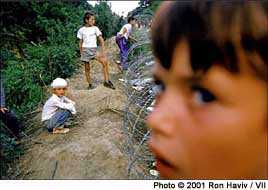 "The
appeal was this concept of self empowerment. I realized that I was brought
along to a certain point in my photography being represented by an agent
but that I needed to take responsibility for myself not just as a photographer
but also on a business level. I think that photographers over the years
have given too much responsibility to their agents and we've all wound
up in this situation, and we've been complicit in it as photographers.
Now is the time to fight back and take control back for ourselves. The
amount of responsibility that we put into the taking of the images,
the amount of concentration, of dedication, devotion and skill, those
skills need to be put in all the way through from start to finish. Then
we all feel much better about our work." "The
appeal was this concept of self empowerment. I realized that I was brought
along to a certain point in my photography being represented by an agent
but that I needed to take responsibility for myself not just as a photographer
but also on a business level. I think that photographers over the years
have given too much responsibility to their agents and we've all wound
up in this situation, and we've been complicit in it as photographers.
Now is the time to fight back and take control back for ourselves. The
amount of responsibility that we put into the taking of the images,
the amount of concentration, of dedication, devotion and skill, those
skills need to be put in all the way through from start to finish. Then
we all feel much better about our work."
Given the photographers involved and the work that they produce it is
extremely unlikely that this venture will fail in the short term, especially
if they stick to their intention of keeping the number of members small.
They are talking about having no more than fourteen photographers (one
of the many VII jokes making the rounds in Perpignan was, if they expand
it to eleven photographers will it be renamed Seven Eleven?). But clearly
this is not a structure that would work with any other group except
one of a similar high profile. This is not the way a group of newcomers
could position representation. The interesting aspect of this launch
from an industry point of view is that it is yet another example of
the growing movement of photographers taking the reins into their own
hands. Although the whole may not be applicable to photographers working
under different circumstances, many of the parts, and especially the
motivation may be.
Several times during both the interview and the press conference Jim
Nachtwey used the word "forged". One of the strengths of VII
as he sees it is that: "It's grounded in this friendship that's
been forged in fire." Friendships that are formed under such circumstances
are remarkable resilient, but for seven strong personalities such as
these the long term survival of the agency will depend upon how well
tempered is the steel that the flames produced.
© 2001 Peter
Howe
Contributing Editor
peter.howe@verizon.net
|
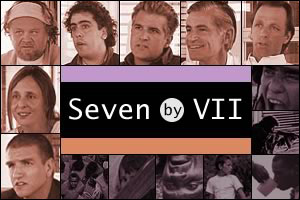
 Shortly
before the press conference that would be the vehicle for the announcement
The Digital Journalist was given an exclusive interview with
all of the photographers and VII's managing editor Ashley Woods. Their
attendance at this year's Visa was the first time ever that they had
all been together in the same room. It is a testament to the revolution
in communication that the seven photographers, Alexandra Boulat, Ron
Haviv, Gary Knight, Antonin Kratochvil, Christopher Morris, James Nachtwey
and John Stanmeyer, could conceive, structure and realize an agency
without the need to have a meeting with everyone physically present.
It was also appropriate that the announcement should have been in Perpignan
because it was at Visa the previous year that the final decision to
move ahead was made by Alexandra, Gary and Ron in a nearby café.
Shortly
before the press conference that would be the vehicle for the announcement
The Digital Journalist was given an exclusive interview with
all of the photographers and VII's managing editor Ashley Woods. Their
attendance at this year's Visa was the first time ever that they had
all been together in the same room. It is a testament to the revolution
in communication that the seven photographers, Alexandra Boulat, Ron
Haviv, Gary Knight, Antonin Kratochvil, Christopher Morris, James Nachtwey
and John Stanmeyer, could conceive, structure and realize an agency
without the need to have a meeting with everyone physically present.
It was also appropriate that the announcement should have been in Perpignan
because it was at Visa the previous year that the final decision to
move ahead was made by Alexandra, Gary and Ron in a nearby café.
 "The
focus [of VII] is very tight. We're committed to the same kind of documentation
of contemporary history, therefore we have many interests in common,
and we have many needs in common. This particular group with this particular
profile enables us to maintain a sharp focus on the things that are
meaningful to us as photographers. Through the years the friendships
that we have with each other are collegial relationships that have been
forged in extremely difficult situations. Those relationships that have
been forged in the field in real working conditions have brought us
together and that's what is going to keep us together."
"The
focus [of VII] is very tight. We're committed to the same kind of documentation
of contemporary history, therefore we have many interests in common,
and we have many needs in common. This particular group with this particular
profile enables us to maintain a sharp focus on the things that are
meaningful to us as photographers. Through the years the friendships
that we have with each other are collegial relationships that have been
forged in extremely difficult situations. Those relationships that have
been forged in the field in real working conditions have brought us
together and that's what is going to keep us together." "We're
not photographers who are in need or in constant search of work. If
one of us needs to go to Israel or one of us needs to do a story on
Indonesia we can get there. We don't have to use the agency's resources
to get there. We are constantly producing stories because we are constantly
on assignment. Right away that separates our agency."
"We're
not photographers who are in need or in constant search of work. If
one of us needs to go to Israel or one of us needs to do a story on
Indonesia we can get there. We don't have to use the agency's resources
to get there. We are constantly producing stories because we are constantly
on assignment. Right away that separates our agency." Alexandra
Boulat brings a different perspective to the issue. She feels that there
is a real possibility that for her, and maybe some of the others, meeting
in the field is going to be less and less likely as her photography
develops:
Alexandra
Boulat brings a different perspective to the issue. She feels that there
is a real possibility that for her, and maybe some of the others, meeting
in the field is going to be less and less likely as her photography
develops: "The
reason for setting up VII was to ensure our survival in that market
so that we can continue to produce those pictures. We will have strong
relationships with a small number of magazines that we hope will continue
at least in the short term and enable us to bridge the gap before we
hope we will be able to find new resources to produce this work and
it might not be the traditional editorial market. It may well be from
other areas that we will find funding, and that's what we're going to
explore quite aggressively."
"The
reason for setting up VII was to ensure our survival in that market
so that we can continue to produce those pictures. We will have strong
relationships with a small number of magazines that we hope will continue
at least in the short term and enable us to bridge the gap before we
hope we will be able to find new resources to produce this work and
it might not be the traditional editorial market. It may well be from
other areas that we will find funding, and that's what we're going to
explore quite aggressively." "All
of us like to grow in photography. I want to push my photography to
the next level, and this creative combustion between us I'm hoping might
provide that. This will help us keep the focus on our photography. We
don't want to be walking around like a lot of people pissed off right
now who are being cheated by agencies. It takes away their creativity
and so it's become very negative. And I think for me it's become really
positive, and it's like a spring, for me it's like spring in my photography
once again"
"All
of us like to grow in photography. I want to push my photography to
the next level, and this creative combustion between us I'm hoping might
provide that. This will help us keep the focus on our photography. We
don't want to be walking around like a lot of people pissed off right
now who are being cheated by agencies. It takes away their creativity
and so it's become very negative. And I think for me it's become really
positive, and it's like a spring, for me it's like spring in my photography
once again" "The
appeal was this concept of self empowerment. I realized that I was brought
along to a certain point in my photography being represented by an agent
but that I needed to take responsibility for myself not just as a photographer
but also on a business level. I think that photographers over the years
have given too much responsibility to their agents and we've all wound
up in this situation, and we've been complicit in it as photographers.
Now is the time to fight back and take control back for ourselves. The
amount of responsibility that we put into the taking of the images,
the amount of concentration, of dedication, devotion and skill, those
skills need to be put in all the way through from start to finish. Then
we all feel much better about our work."
"The
appeal was this concept of self empowerment. I realized that I was brought
along to a certain point in my photography being represented by an agent
but that I needed to take responsibility for myself not just as a photographer
but also on a business level. I think that photographers over the years
have given too much responsibility to their agents and we've all wound
up in this situation, and we've been complicit in it as photographers.
Now is the time to fight back and take control back for ourselves. The
amount of responsibility that we put into the taking of the images,
the amount of concentration, of dedication, devotion and skill, those
skills need to be put in all the way through from start to finish. Then
we all feel much better about our work."